
Home Competition Rules/Officiating Dave Perry’s 100 Best Racing Rules Quizzes

Rules/Officiating
Dave perry’s 100 best racing rules quizzes.
Boat Q, a doublehanded trapeze boat, wins the race. On shore, Q is listed as OCS on the score sheet. Q makes a scoring request to the race committee and is told that, though her hull was not over the starting line, her crew’s head and shoulders were on the course side of the starting line when she went out on the trapeze seconds before the starting signal. Q requests redress.
You are on the protest committee: how do you decide this?
This quiz was excerpted from Dave Perry's 100 Best Racing Rules Quizzes available from US Sailing . For a comprehensive explanation of the rules, read Dave Perry's Understanding the Racing Rules of Sailing through 2024 , which is also available from US Sailing. Permission to reprint this quiz for non commercial use is granted by the author.
Boat Q is entitled to redress under rules 62.1(a), Redress, and 64.3, Decisions on Redress. She should be scored in her finishing place. The definition Start says that a boat starts: “…when, her hull having been entirely on the pre-start side of the starting line at or after her starting signal… any part of her hull crosses the starting line from the pre-start side to the course side.” Q’s hull is entirely on the pre-start side of the starting line at the starting signal and therefore she starts correctly. It is immaterial where her crew’s body is at the starting signal.
Boats P (on port tack) and S (on starboard tack) are beating to windward. P tacks into a position just in front of S. When P reaches a close-hauled course, she is a few feet clear ahead of S. S, who has not needed to change course prior to that moment to avoid P, immediately luffs above a close-hauled course, avoids contact and protests.
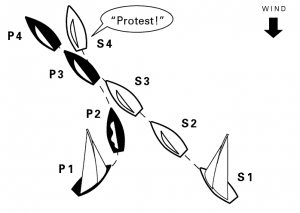
S’s protest is dismissed; neither boat breaks a rule. While P is on port tack she is required to keep clear of S by rule 10, On Opposite Tacks. While P is tacking, she is required to keep clear of S from the moment she passes head to wind until she reaches a close-hauled course by rule 13, While Tacking. A boat “keeps clear” if the right-of-way boat can sail her course with no need to take avoiding action (see the definition Keep Clear). S does not need to take any avoiding action before P reaches a close-hauled course.
When P reaches a close-hauled course, rule 13 ceases to apply and P is the right-of-way boat under rule 12, On the Same Tack, Not Overlapped. Because she acquired the right of way by her actions, P is required to give S room to keep clear of her by rule 15, Acquiring Right of Way. S is able to avoid P in a seamanlike way; therefore P complies with rule 15.
With 30 seconds to go before the starting signal, Boat P (on port tack) on a beam reach, is approaching Boat S (on starboard tack) who is on a close-hauled course. P proceeds to luff and then cross head to wind all in one motion, ending up to leeward of S. Just after P passes head to wind she holds her course, telling S to keep clear because she is on starboard tack and a leeward boat. S luffs to avoid contact with P and protests. You are on the protest committee; how would you decide this?
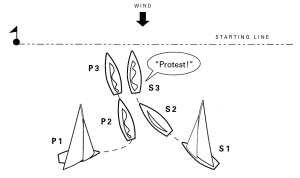
Boat P is penalized under rule 13, While Tacking. When P passes head to wind, she changes tack from port tack to starboard tack. However, rule 13 states that after a boat passes head to wind, she must keep clear of other boats until she is on a close-hauled course; and before she gets to close-hauled, rules 10, 11 and 12 do not apply. Rule 11, On the Same Tack, Overlapped, is the windward/lee- ward rule. P has not borne away to a close-hauled course when S has to change course to avoid contact; therefore P breaks rule 13.
Thirty seconds before the starting signal, Boat W is nearly wayless, her sails flapping. About one length prior to becoming overlapped to leeward, Boat L hails, “Leeward boat!” W takes no evasive action. One second after L becomes overlapped to leeward of W, L has to bear away to avoid contact with W. W begins trimming her sails and heading up immediately after the overlap is established. L protests. The protest committee finds that W, having been given adequate warning of the impending situation, fails to keep clear of a leeward boat, thereby breaking rule 11, On the Same Tack, Overlapped. W appeals. You are on the appeals committee; how would you decide this?

Boat W’s appeal is sustained; neither boat is penalized. Adequate time for response is incorporated into rule 15, Acquiring Right of Way, by its requirement to initially allow a newly obligated boat “room to keep clear.” This rule does not require a boat clear ahead to anticipate her requirement to keep clear as a wind- ward boat before the boat clear astern becomes overlapped to leeward. When L becomes overlapped and therefore the right-of-way boat, rule 15 requires her to give W “room to keep clear,” which she does by immediately bearing away and giving W space to maneuver away from her. Though W is momentarily breaking rule 11, On the Same Tack, Overlapped, when L has to change course to avoid contact, W is trimming her sails and heading up; therefore she is sailing within the room she is entitled to, and is exonerated (freed from penalty) for breaking rule 11 by rule 43.1(b), Exoneration. Thereafter she keeps clear, fulfilling her obligation under rule 11. (See US Sailing Appeal 119 and World Sailing Case 53.)
Two 25-foot boats, L (a leeward boat) and W (a windward boat), are approaching the right-hand end of the starting line, a 30-foot powerboat, to start an upwind leg. Both boats are beam reaching, with L on a course to pass one length to leeward of the race committee boat. Twenty seconds before the starting signal and when two lengths from the race committee boat, L hails, “No room! Don’t go in there!” to W. Both boats hold their courses until W is overlapped to leeward of the race committee boat. At that point L luffs and W makes con- tact nearly simultaneously with both L and the committee boat. There is dam- age to the starboard side of L but not serious damage. Both boats protest each other. You are on the protest committee; how would you decide this?
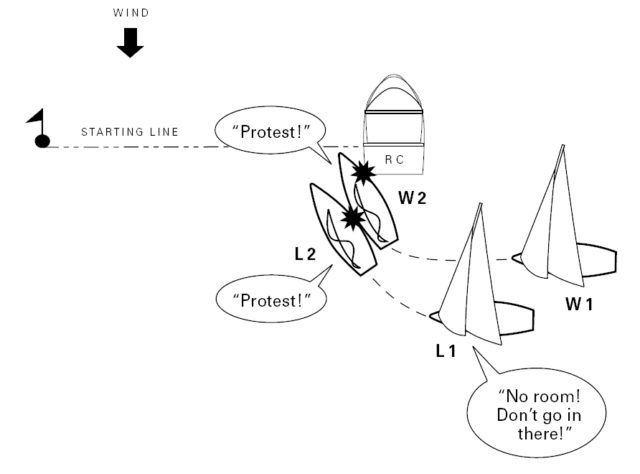
Boat L is penalized under rules 14, Avoiding Contact, and 16.1, Changing Course. The preamble to Part 2, Section C, At Marks and Obstructions, states that rules 18, Mark-Room, 19, Room to Pass an Obstruction and 20, Room to Tack at an Obstruction, do not apply “at a starting mark surrounded by navigable water or at its anchor line from the time the boats are approaching them to start...”. Therefore the situation is governed by the rules in Sections A and B. At the time W becomes overlapped to leeward of the race committee boat, she is keeping clear of L in compliance with rule 11, On the Same Tack, Overlapped (Section A rule). Rule 16.1 requires L, as a right-of-way boat, to give W room to keep clear of her when she changes her course (Section B rule). When L luffs, there is not room (space) for W to comply with the Part 2 rules and rule 31, Touching a Mark, due to the physical presence of the race committee boat (see the definition Room). Therefore L breaks rule 16.1. W breaks rules 11 and 31 but is exonerated (freed from penalty) by rule 43.1(b), Exoneration.
L also breaks rule 14 for failing to avoid a collision, and is penalized under that rule because the contact results in damage to herself. However, from the time L begins to luff, it is not possible for W to avoid contact; therefore W does not break rule 14.
Had L wanted to prevent W from passing between her and the committee boat, she should have luffed sooner while W was still able to respond to her luff without making contact with the committee boat (see World Sailing Cases 114 and 146).
Boats W (a windward boat) and L (a leeward boat) are reaching towards the gybe mark on converging courses. L becomes overlapped with W from clear astern within two of her lengths of W. They are both sailing proper courses and are on a collision course. As they near each other, W hails, “You came from clear astern and I’m on my proper course.” L replies, “I’m on my proper course.” W’s boom then touches L with no damage or injury and both protest.
You are on the protest committee; how would you decide this?
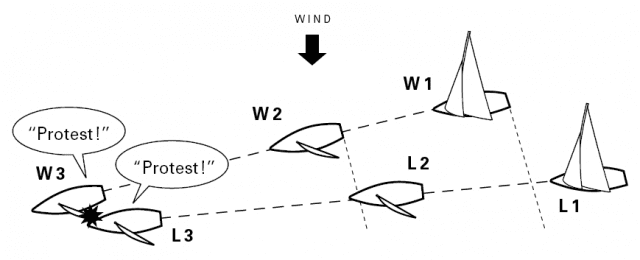
Boat W is penalized under rule 11, On the Same Tack, Overlapped, for failing to keep clear of a leeward boat, and rule 14, Avoiding Contact, for failing to avoid contact when it was reasonably possible to do so. When L first becomes overlapped with W, she is required to give W room to keep clear by rule 15, Acquiring Right of Way, which she does. Because L overlaps W from clear astern within two of her hull lengths, rule 17, On the Same Tack; Proper Course, requires L not to sail above her (L’s) proper course. L is sailing on her proper course (not above it) and W fails to keep clear.
L could have avoided making contact with W, but didn’t; therefore she breaks rule 14. But a right-of-way boat is exonerated (freed from penalty) for breaking rule 14 when the contact does not cause damage or injury (see rule 43.1(c), Exoneration).
Two 18-foot boats, L (a leeward boat) and W (a windward boat), are approaching the left-hand end of the starting line, which is a 16-foot powerboat. When W is three lengths from the end of the line, L becomes overlapped on W to leeward from clear astern. There are six seconds to go before the starting signal. L slowly luffs and W keeps clear. As L reaches close-hauled, the starting signal is made. L is a boat length from the powerboat and will not clear it sailing close-hauled. She luffs to head to wind, shooting up and around the powerboat, and then bears away to a close-hauled course. W keeps clear through- out, and protests L for sailing above close-hauled after the starting signal.
You are on the protest committee: how would you decide this?
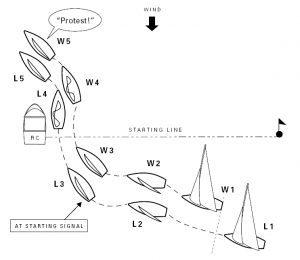
Boat W’s protest is disallowed. The 16-foot powerboat ranks as both a “mark” and an “obstruction” to the 18-foot boats (see the definitions Mark and Obstruction). The preamble to Part 2, Section C, At Marks and Obstructions, states that the rules of Section C, which include rule 18, Mark-Room, and rule 19, Room to Pass an Obstruction, do not apply “at a starting mark surrounded by navigable water.” Therefore the situation is governed by the rules of Sections A and B.
L becomes overlapped to leeward from clear astern of W. Therefore, rule 17, On the Same Tack; Proper Course, requires her to not sail above her proper course. Before the starting signal L has no proper course (see the definition Proper Course); therefore she is free to sail up to head to wind, provided that when she changes course she gives W room to keep clear (rule 16.1, Changing Course).
After the starting signal, L is required to not sail above her proper course. In this case her “proper course” (the course she would choose in order to sail the course and finish as soon as possible in the absence of W) is to luff head to wind, coast past the powerboat and then bear away to a close-hauled course (see the definition Proper Course). L sails no higher than this course, and there- fore does not break rule 17. And while she is changing course, L gives W room to keep clear under rule 16.1 as demonstrated by W’s performance. W correctly keeps clear under rule 11, On the Same Tack, Overlapped.
In a post-race conversation, the helmsman of Boat X complains to a member of the protest committee that he clearly saw another boat in his race, Boat Y, touch the gybe mark and not take a penalty turn. The protest committee member therefore decides to protest Y for an alleged breach of rule 31, Touching a Mark. Y is informed that she is being protested, and the protest is filed within the time limit.
The protest is not valid and therefore its hearing should be closed under rule 63.5, Validity of the Protest or Request for Redress. Rule 60.3, Right to Protest; Right to Request Redress or Rule 69 Action, governs the action by the protest committee in this case, and states that a protest committee cannot protest as a result of a report from a person who has a conflict of interest (with an exception that doesn't apply in this case). Because all the requirements for a protest have not been met, the protest is not valid. When competitors witness alleged breaches of the rules, and they want the incident to go to a hearing, they must act themselves according to rule 60.1, Right to Protest; Right to Request Redress or Rule 69 Action.
During the hearing of a request for redress, the protest committee learns that Boat X has touched a mark during the race. The protest committee protests X, giving her time to prepare, etc., holds a protest hearing with X in attendance, and disqualifies her for breaking rule 31, Touching a Mark. X appeals. You are on the appeals committee; how would you decide this?
Boat X’s appeal is sustained and the protest committee’s decision is reversed. Boat X is reinstated in the race. Rule 60.3(a), Right to Protest; Right to Request Redress or Rule 69 Action, says that the protest committee cannot protest a boat as a result of information in a request for redress.
After a race held in the United States, Boat X requests redress claiming that the leeward mark was out of position. The notice of race and sailing instructions make no mention of the US Sailing prescriptions to the rules. The protest committee posts on the official notice board that Boat X has requested redress, and the time and place of the hearing. The skipper of Boat Y asks the protest committee if he can sit in on the hearing, and is told no. However the protest committee calls him to give evidence as a witness. The protest committee decides that the mark was out of position and abandons the race. Boat Y is not a party to the hearing, so her representative cannot appeal (see rule 70.1(a), Appeals and Requests to a National Authority). However the protest committee requests confirmation or correction of its procedures and decisions under rule 70.2, Appeals and Requests to a National Authority.
The protest committee’s procedures and decisions are incorrect. When racing under The Racing Rules of Sailing , the prescriptions of the national authority for the country in which the race is being held apply, unless they are changed by the notice of race or sailing instructions in compliance with that national authority’s prescription, if any, to rule 88.2, Changes to Prescriptions. See rule 4, Acceptance of the Rules, and the definition Rule.
The US Sailing prescription to rule 63.2, Time and Place of the Hearing; Time for Parties to Prepare, requires the protest committee to notify all boats in a race of the time and place of all redress hearings, and inform all boats of the reason for the request. Additionally, the prescription gives each boat in a race the right to participate in all redress hearings relating to that race. Furthermore, when a boat chooses to participate in the hearing, the prescription requires the protest committee to request redress for that boat, which it can do under the US Sailing prescription to rule 60.3(b), Right to Protest; Right to Request Redress or Rule 69 Action. The protest committee does not need to state the reason for the request.
By requesting redress for a boat, the protest committee makes that boat a party to the hearing, with the full rights of a party in Part 5, Section B, Hearings and Decisions, including the right to be present when all the evidence is present- ed, ask questions, and give testimony. A party also has the right to appeal under rule 70.1(a), Appeals and Requests to a National Authority.
US Sailing also prescribes to rule 63.1, Requirements for a Hearing, that: “A request for redress based on a protest committee decision shall, when practicable, be heard by a committee that contains no members of the committee that made the original decision.” Given that the protest committee did not correctly follow the requirements in the US Sailing prescription to rule 63.2, and has heard testimony and made a decision, it would be reasonable for the appeals committee to order that a new hearing be held by a different protest committee (see rule 71.2, National Authority Decisions), reminding the new protest commit- tee to properly notify all boats in the race or series of the reason for the redress request and the time and place of the hearing, which may be a teleconference call.
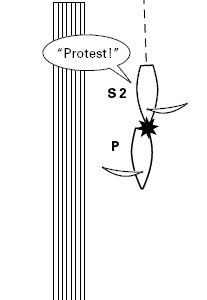
Boat P is penalized for breaking rules 10, On Oppo- site Tacks, and rule 14, Avoiding Contact. Though the boats are passing an obstruction (the dock), they are not overlapped, so no part of rule 19.2, Giving Room at an Obstruction, applies. Therefore, although P is clear ahead when she first reaches the obstruction, she gets no protection from rule 19.2 once she and S begin passing the obstruction, and she must therefore keep clear of S under rule 10.
Regarding rule 14, it is reasonably possible for P to avoid contact with S by moving out of her way. She fails to do so and breaks rule 14 as a result. It is similarly reasonably possible for S to avoid contact with P, so she also breaks rule 14. However, a right of way boat is exonerated (freed from penalty) by rule 43.1(c), Exoneration, for breaking rule 14 when the contact does not cause damage or injury. In this case it caused neither; therefore S is not penalized.
Boats P and S, racing to an upwind finishing line, are approaching the left-end finishing mark on opposite tacks. S is sailing a close-hauled course on the star- board-tack layline to the mark. P has overstood the port-tack layline and is sailing about 10 degrees below a close-hauled course. S hails, “Starboard!” and P hails, “Room!” S avoids P and protests. In the protest hearing, P claims that she was not sailing close-hauled and therefore she was not on a “beat to wind- ward,” and that she did not need to tack to finish (i.e., to sail her proper course). Therefore, she was entitled to mark-room from S.
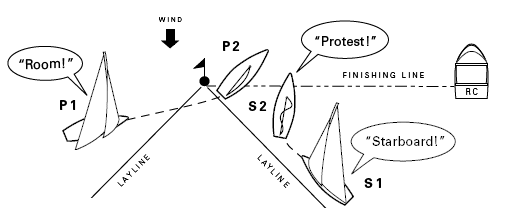
Boat P is disqualified. She fails to keep clear of Boat S under rule 10, On Oppo- site Tacks. Rules 18.1(a) and 18.1(b), Mark-Room: When Rule 18 Applies, state that rule 18 does not apply when boats are on opposite tacks on a beat to wind- ward, or when the proper course at the mark for one but not both of the boats is to tack. Clearly P does not need to tack to sail her proper course (i.e., to finish as quickly as possible; see the definition Proper Course). But S and P are both on a “beat to windward” because they are sailing to an upwind mark and the reason they are not both sailing close-hauled courses is because P has overstood the close-hauled layline to the mark. Therefore rule 18 does not apply and P must keep clear of S under rule 10, which she fails to do. (See World Sailing Case 132.)

Andrew Clouston SVP Programs & Services Email Andrew Clouston

Matthew Hill Race Administration Director Email Matthew Hill 401-342-7948

Judie McCann Race Administration Coordinator Email Judie McCann 401-342-7945
Copyright ©2018-2024 United States Sailing Association. All rights reserved. US Sailing is a 501(c)3 organization. Website designed & developed by Design Principles, Inc. -->

Dave Dellenbaugh Sailing
David Dellenbaugh is a champion helmsman, tactician, author, coach, rules expert and seminar leader who has spent his career helping sailors sail faster and smarter.Here are the learning resources that he has created to help you improve your racing skills.
- Racing Rules
- Rule Quizzes
Here is a rules quiz from a recent issue of Speed & Smarts. All the answers to these questions can be found in Learn The Racing Rules 2024, or here . Check back for future quizzes.

- The Newsletter
- Current Issue
- See a Sample Issue
- Get a FREE Sample Issue
- Newsletter Index
- Renew Subscription
- Gift Subscriptions
- Order Back Issues
- Testimonials
- Contributors
- Get Promotional Issues
- Reprint Permission
- Free back Issues
- Speed & Smarts Gift Card
- Learn the Racing Rules
- Buy Racing Rules Course
- Contents List
- 8 Reasons to get ‘LTRR 2024’
- Sample Video
- Log in to your LTRR 2024
- Webinar Schedule
- Webinar Replays
- Webinar Description
- Instructors
- Seminar Testimonials
- Order Workbooks
- Host a Webinar
- Pay for Webinar
- Services Offered
- Coaching Resume
- Winning Tips
- Around the Buoys
- Smallboat Sailing
- The FAST Course
- The SMART Course
- Miscellaneous

Casual Sailing Windsurfing Buying a Boat For Sale Weather and Tides Racing Race Results Past Race Results
Racing rules quiz, section 1 - the start.

15 seconds before the gun, Blue is close hauled to the Boat End and Red is reaching in, Both on Starboard. If no one moves they will collide.
Is Red entitled to room here?
That's not right
Preamble of section C states that rule 18 does not apply at a starting mark surrounded by navigable water. Therefore rule 11 applies and the windward boat (Red) must keep clear and is not allowed to hold her course. The leeward boat (Blue) is bound only by her duty to avoid a collision with damage (rule 14). Since Blue has not changed course, rule 16 does not apply.

Blue and Red are both reaching on starboard to the Boat End for the start. Just before the gun, blue luffs up to the line, cutting off Red's approach. Red protests.
Does Red have a valid protest?
In accordance with rule 16.1 Blue may not change her course so late, because Red by this time no longer has room to keep clear. Blue should have luffed earlier, if she wanted to close the gap. There is no rule, that requires of a boat (here: Red) to anticipate an action of another boat (here: Blue's luff towards the starting line), even if this action is to be expected.
That's not right

Blue and Red are approaching the Boat End on starboard. Blue is ahead and heads up towards the Start Boat to reach the line close hauled at the gun. Red has to take avoiding action.
Preamble of section C states that rule 18 does not apply at a starting mark surrounded by navigable water from the time the boats are approaching it to start until they have passed it. Therefore, only rule 16 restricts Blue's luffing of the red boat. Blue may luff to head to wind and close the gap left for Red provided Blue leaves Red enough room to keep clear - which she does! Before Red reached the RC boat, Blue had changed course such that she would leave no room for a boat to pass between him and the RC boat. Red had to realize and expect this, and had to react (by luffing up on the wrong side of the RC boat, for instance) before sailing himself into the impossible situation she ended up in. Now Red will force Blue to give room to avoid the collision, and in doing so, Red will foul Blue.

Blue and Red are heading to the Pin End as the gun is fired. Blue is slightly ahead but there is an overlap. Blue will miss the pin on the current heading but has enough momentum to pass the pin by pinching, which she does. Red tacks away to avoid the collision.
Is Blue entitled to room here?
Preamble of section C states that Rule 18 does not apply at a starting mark, but Rule 11 (boats on the same tack, overlapped) requires the windward boat (Red) to keep clear of the leeward boat (Blue). Blue is allowed to luff up to head to wind, but no further. Blue's luffing is only restricted by rule 16, i.e. she must change course moderately enough that Red can keep clear.

Red is luffing on Starboard when Blue approaches from behind the sail on Port to tack beneath Red, but whist she passes through to starboard she does not reach the closed hauled position. She blocks Red's way and Red calls for room. Blue protests saying the windward boat should have kept clear.
Does Red have a right to room?
Blue will be penalized. She did not bear away to a close hauled course after beginning her tack. Therefore rule 13 still applies and Blue should be keeping clear of Red. But she does not.
Inspired by the on line quiz at http://game.finckh.net/indexe.htm . Please contact us if any feedback or concerns.

Sailing Rules Quiz

Uli and Wolfi Finckh
Follow this link to an on-line Sailing Rules Quiz courtesy of Uli and Wolfi Finckh. You can play the game in a number of different ways: by rule number, at different positions around a course, or play it at random but set the difficulty level to suit your needs.
This an excellent site, well worth a visit to learn more about the rules and to test your knowledge. Suitable for both the novice and expert.

- CLASSIFIEDS
- NEWSLETTERS
- SUBMIT NEWS

UK-Halsey Sailmakers post new online Rule Quiz
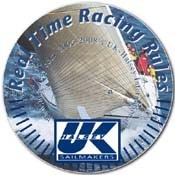
Related Articles
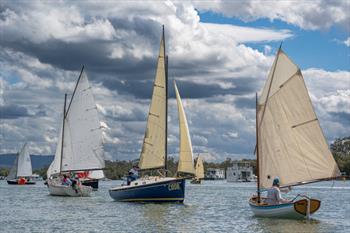

Sail Fast, Sail Safe, Have Fun
FRIDAY'S TFE LIVE: Edit and Peter Harken (USA) via Skype from Pewaukee

MOB: Sending in a Second Soul?

TFE LIVE: Today, Richard Pound (CAN), longest serving member of the IOC, with his views on the postp

TFE LIVE: Today, Terry Hutchinson (USA), Skipper and Executive Director of NYYC's American Magic

Rules Quiz (updated): Under the Racing Rules of Sailing, which yacht has right-of-way?
Join our mailing list
Get an email when there is BREAKING NEWS or a MUST READ.
More sailing news...
Americascup.com, latitude 38, pressure drop, sail couture, sailing anarchy, sailing magazine, scuttlebutt na, scuttlebutt europe, sailing world, sail racing magazine, sail-world usa.
Sail Fast, Have Fun
Editorial offices , auckland, nzl, lymington, gbr, newport beach, ca usa, newport, ri usa, san diego, ca usa, san francisco, ca usa, sailingillustrated@, facebook.com/, sailingillustratedblog, @sailillustrated, copyright © 2019, t f ehman jr, all rights reserved.


Rules 21-23 – Keeping Clear, Avoiding, Interfering: Racing Rules of Sailing 2021-2024
Section D, Other Rules, is the final section of Part 2, When Boats Meet. Section D contains rules 21-23 addressing topics that do not fit neatly into Sections A-C.
In 2018, the Inland Lake Yachting Association (ILYA) and SailZing, LLC partnered on a Fair Sailing initiative. As part of this initiative, SailZing worked with the ILYA and UK Sailmakers to develop a series of articles on the rules. With the rules changes in 2021, SailZing is updating these articles and adding video summaries.
2021 Changes to Rules 21-23
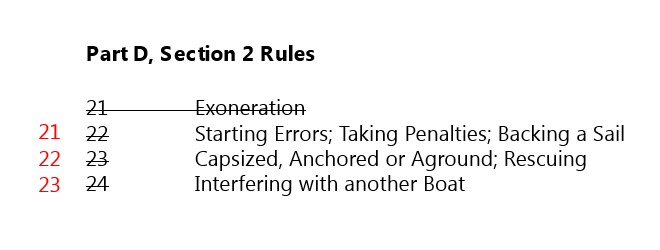
For the 2021 rules, World Sailing revised previous Rule 21 – Exoneration, and moved it to Rule 43 in section 4 of the rules. This left only three rules in Section D, re-numbered as rules 21-23.
Other than re-numbering, there were no other significant changes to the rules in this section. One minor wording changes to Rule 21 is shown in red.
Rule 21 – Starting Errors; Taking Penalties; Backing a Sail
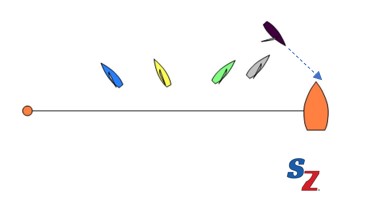
“21.1 A boat sailing towards the pre-start side of the starting line or one of its extensions after her starting signal to start or to comply with rule 30.1 shall keep clear of a boat not doing so until her hull is completely on the pre-start side.
21.2 A boat taking a penalty shall keep clear of one that is not.
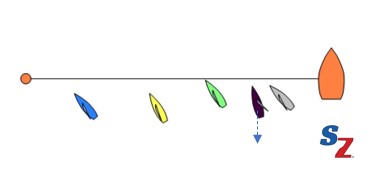
21.3 A boat moving astern, or sideways to windward, through the water by backing a sail shall keep clear of one that is not.”
Rule 21 Key Points
- Rule 21 removes the right-of-way protections (Section A rules) for boats re-starting, taking a penalty, or moving backwards/sideways by backing a sail. The preamble to Section D emphasizes this. It states: “When rule 21 or 22 applies between two boats, Section A rules do not.”
Rule 22 – Capsized, Anchored or Aground; Rescuing
“If possible, a boat shall avoid a boat that is capsized or has not regained control after capsizing, is anchored or aground, or is trying to help a person or vessel in danger. A boat is capsized when her masthead is in the water.”
Rule 22 Key Points
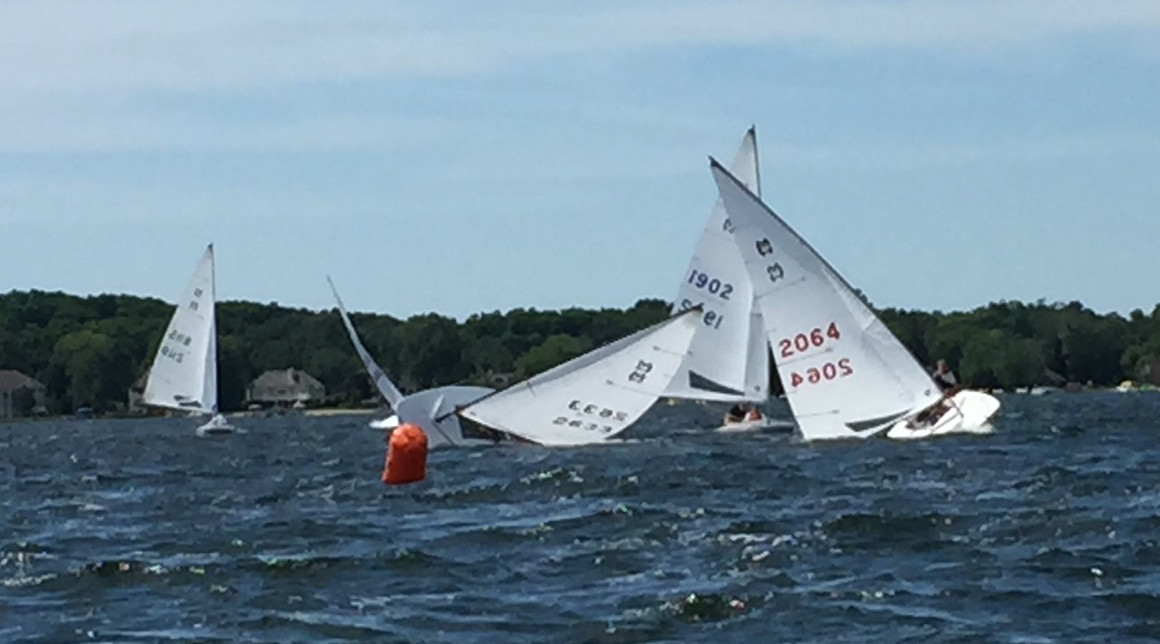
Don’t get too close to a capsized boat. You never know what might happen. As the picture shows, the situation can change rapidly in heavy air.
Rule 23 – Interfering with another Boat
“23.1 If reasonably possible, a boat not racing shall not interfere with a boat that is racing .
23.2 If reasonably possible, a boat shall not interfere with a boat that is taking a penalty, sailing on another leg or subject to rule 21.1. However, after the starting signal this rule does not apply when the boat is sailing her proper course.”
Rule 23 Key Points
- When multiple fleets are sailing the same course, fleets that are not in the starting sequence should stay well clear of the starting area.
- After finishing, sail well outside of the laylines to the finishing line.
- Rule 23.2 may seem to conflict with Rule 21, which requires boats taking a penalty or re-starting to keep clear. However, note the last sentence in rule 23.2. After the start, you can’t deviate from your proper course to interfere with boats re-starting, taking penalties, or on another leg. If you’re sailing your proper course, you don’t have to worry about interfering with these boats.
Definitions
Racing A boat is racing from her preparatory signal until she finishes and clears the finishing line and marks or retires, or until the race committee signals a general recall, postponement or abandonment
World Sailing Cases of Interest for Section D
126 – when does a boat finish? 127 – are boats that make an error in sailing the course considered to be racing?
Related Content:
SailZing – Racing Rules Category World Sailing – Racing Rules

Related Posts

2017-2020 Racing Rules of Sailing: 8 Key Changes
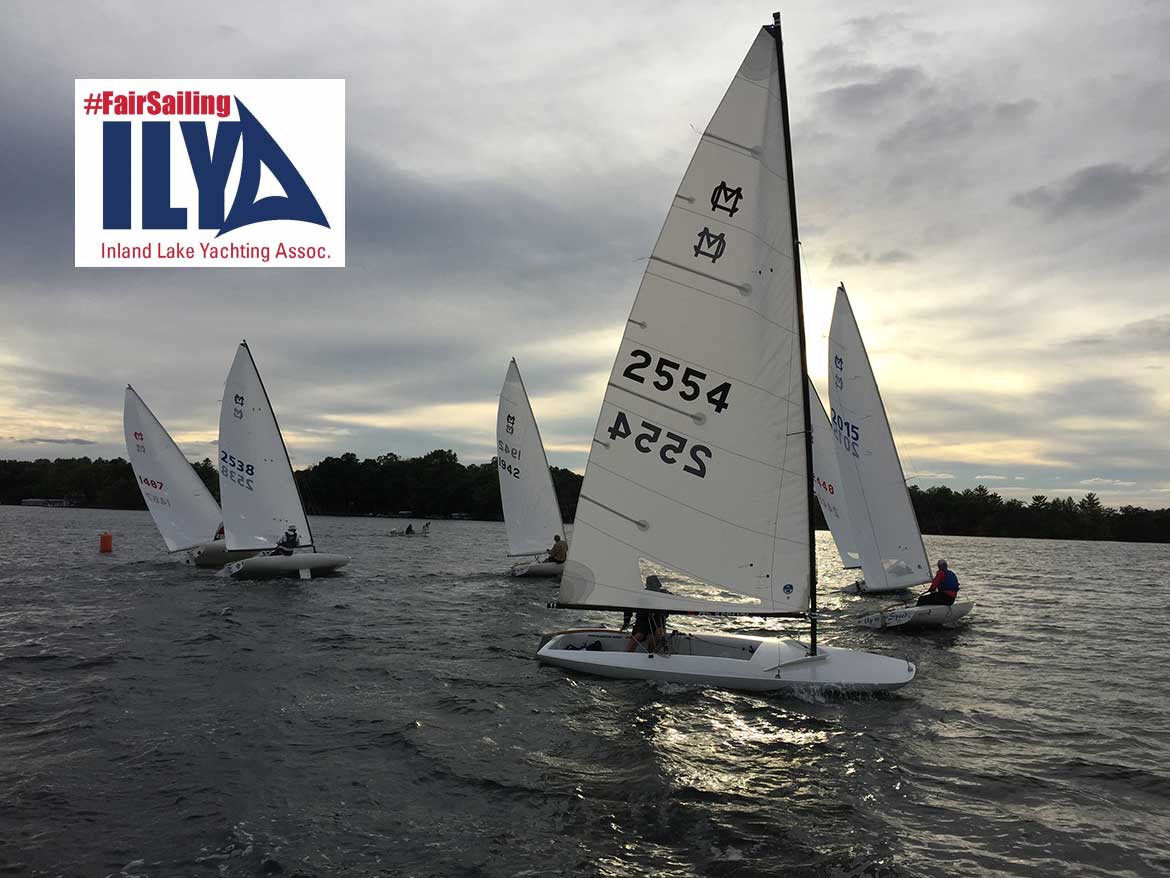
ILYA #FairSailing Initiative Racing Rules Quiz – Level I
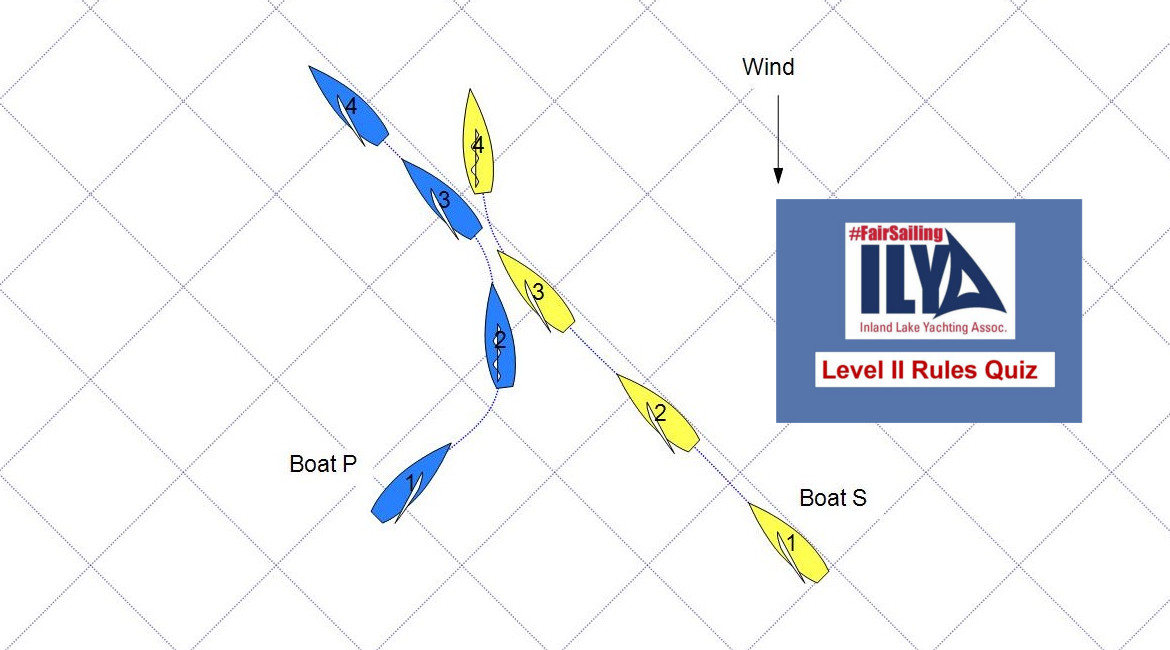
ILYA #FairSailing Initiative Racing Rules Quiz – Level II
Leave a comment cancel reply.
You must be logged in to post a comment.
This site uses Akismet to reduce spam. Learn how your comment data is processed .
Insert/edit link
Enter the destination URL
Or link to existing content

Published on May 15th, 2024 | by Editor
Is level racing possible with handicaps?
Published on May 15th, 2024 by Editor -->
Yacht designer and past Seahorse magazine editor Julian Everitt shares a complex topic in this Facebook post about rating rules and racing:
Could Ton Cup style level racing provide a resurgence in grand prix top class offshore racing from Minis to Maxis? A top flight offshore competitor asks, “Is IRC or ORC up to the task?”
The ‘almost-level’ handicap inshore One Ton of today, fought out in IRC rule Fast 40s, has not proven to have much growth potential. So here is the question from a long-term offshore racing owner, skipper and RORC member:
“Once again, ORC seem to be creating tools and interest, with its SPEED GUIDES, that our IRC cannot. Love or hate ORC, their marketing and voice is heard above IRC. As Rear Commodore of the RORC 2016-2019, I tried to action change to the way the rule was marketed and communicated to little effect.

“The main step we made was to wrestle control away from the French office but even that was a financial fudge! So, as with the latest bulletin, the ORC have more interesting tools and can therefore potentially engage better with the owner base with much more to offer in regard to comparative performance information.
“I would be interested to know what you think about what the strategy should, or could be, for the future in regard to the use of IRC or ORC. Or are we destined to a future of sailing one designs or classics!?”
ANSWER: I think the ORC model is fundamentally more interesting because it is open. They actually have something they can promote with comparison tools – either boat against boat or as with the so-called speed guide – a way of measuring your ability to sail your own boat against its theoretical performance.
IRC, on the other hand doesn’t have much that it can promote due to its antiquated secrecy rules. The IRC is very good at patting itself on the back saying how successful it is, but at the end of the day, that isn’t actually that interesting.
The ORC rule based, as it is, on supposedly accurate scientific performance data, should be wiping the floor with IRC in terms of popularity as both a club level cruiser racer handicap rule and a full-on grand prix rating system – but it’s not.
So, you have to ask yourself why not? Why wasn’t the established offshore rating rule body able to make a seamless change from IOR to IMS and then to the ORC Rule? Well, it would seem that despite the vastly greater PR value inherent in the scientific solution to offshore sailboat handicapping, the general sailing public still prefer the haphazard linear measurement system enshrined in IRC.
But to add to the problem of which solution is inherently more saleable to the racing boat owners, we have gigantic anomalies in both rules. They both pride themselves, in their sales pitches, that their respective formulas can measure any kind of monohull sailing boat. With the VPP based ORC this would seem, on the face of it, to be an honest and achievable goal and one that is open to scrutiny. However, the reality though is very different.
The rule is intensely type forming which seems to be a contradiction of the very cornerstone of the rule, that is supposed to allow it to accurately measure actual performance differences in hull forms and rig configurations. Why therefore is there a type formed solution? It makes no sense whatsoever.
If the formulas are working properly, then it shouldn’t matter at all what displacement you choose, how much beam, how much sail area, how much keel depth, or even underbody configuration. Anything should be rated with a ‘fair’ handicap based on its performance potential – even a long-keeled boat.
Indeed, if the VPPs worked at all, you could have a hugely disparate fleet racing as close as a bunch of One Designs. But two elements work against the popularity of ORC: 1) The perceived complexity. 2) The total failure to produce a product that actually does what it says on the can.
IRC isn’t much better except the rule helps demonstrate that human nature quite likes the random elements of a linear measurement system together with a big dollop of empirical judgement. The secrecy element is just paranoia. To be frightened by the cost effects of unleashing untold development of new boats by hungry designers – well that horse has already bolted in an undignified rush to obtain ‘optimized’ rating certificates. (Something which, incidentally, is effectively banned by the rules own Rule 2.5 – but who seems to care?)
The owners are simply paying big bucks for the designers to ‘guess’ and then get their interpretation of an optimum ratified by a secret formula. It’s crazy and wholly unnecessary. If IRC was actually braver in using its fudge factors, it could control unseaworthy developments very easily.
But just as with ORC, there is a lie at the core of IRC. It again, like ORC, purports to be able to measure almost anything you throw at it, which kind of implies that a fair rating will be produced for whatever hull form, rig configuration that comes along. But this is clearly not true and for reasons that are mystifying IRC, produces intensely type formed, optimized yachts.
Its real value should be returned to its roots. A rule that is very good at rating a mixed fleet, it undoubtedly is, but as a rule for rating development boats, it is completely useless except to those looking through the narrow prism of fashion.
Neither of these rules are effective at producing level rating classes. The very kind of racing that was so popular under IOR and which just about everybody craves today: top level racing without handicap.

Tags: IRC , Julian Everitt , ORC , rating rule
Related Posts
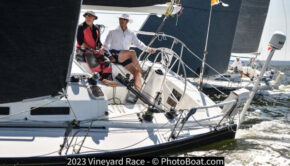
Fairness questions amid complex scoring →
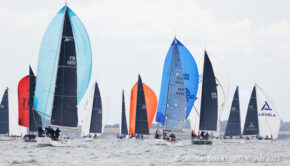
Learning about the ORC rating system →

To make sailing fair for everyone →

Weather forecasts to aid Transpac 2025 →
Comments are closed.
© 2024 Scuttlebutt Sailing News. Inbox Communications, Inc. All Rights Reserved. made by VSSL Agency .
- Privacy Statement
- Advertise With Us
Get Your Sailing News Fix!
Your download by email.
- Your Name...
- Your Email... *
- Name This field is for validation purposes and should be left unchanged.


- Find A School
- Certifications
- North U Sail Trim
- Inside Sailing with Peter Isler
- Docking Made Easy
- Study Quizzes
- Bite-sized Lessons
- Fun Quizzes
- Sailing Challenge

Charting Seas and Dreams: Jimmy Cornell’s Lifetime of Sailing Adventure & Essential Voyage Planning Insights
By: Zeke Quezada, ASA American Sailing , Cruising Tips , Elearn , Inside Sailing , online course , Safety , Sailing History
Jimmy Cornell: A Lifetime of Sailing Adventure
Jimmy Cornell is a legend in sailing; his name is synonymous with daring voyages, meticulous planning, and a deep respect for the sea. With three circumnavigations under his belt, including voyages to remote regions like Antarctica and the Northwest Passage, Cornell’s sailing career is a testament to his passion for adventure and commitment to safety and preparation.
Jimmy sat down with American Sailing for an interview before his online class on voyage planning . Cornell reflected on his remarkable journey and shared insights into the changing landscape of sailing, emphasizing the importance of voyage planning, safety, and adaptation in today’s maritime environment.

A Childhood Dream Realized
Cornell’s fascination with sailing traces back to his earliest memories of wearing a sailor’s suit at age three or four. Growing up under a communist regime in Romania, sailing was forbidden, but a chance encounter with the book Kon-Tiki ignited Cornell’s determination to pursue a life at sea. After settling in London and learning to sail with the BBC yacht club, Cornell embarked on his first world voyage with his wife and two young children, setting the stage for a lifelong love affair with the ocean.
Voyage Planning in a Changing World
Cornell’s upcoming online class with American Sailing focuses on voyage planning in the face of climate change. Cornell explains, “One of the most noticeable phenomena is the gradual decrease in the regularity and reliability of trade winds, as witnessed by sailors on some of the frequently traveled ocean routes.”
Cornell emphasizes the need for careful planning and awareness of changing conditions to ensure safe passage in today’s maritime environment. Safety remains paramount in Cornell’s approach to sailing. He advises sailors to avoid critical areas during tropical storm seasons and to maintain a cautious mindset when planning voyages. By staying informed and vigilant, sailors can minimize risks while pursuing their sailing dreams.
“I wish to stress that caution lies at the heart of voyage planning, and by being aware of these changing circumstances, as well as the greatly improved reliability of long-term weather forecasts, it is still possible to plan a safe voyage even in these changing times.” Jimmy Cornell

Common Misconceptions in Voyage Planning
Cornell dispels common misconceptions among sailors, stressing the importance of traditional navigation methods alongside modern technology. He advocates for using paper charts and pilot charts in voyage planning, emphasizing the need for a comprehensive approach combining old and new techniques.
“You cannot plan a long ocean passage on an iPad or iPhone screen. You need a small-scale paper chart to see not only the details of your planned route but also possible detours and alternatives” Jimmy Cornell
Cornell’s book, “ World Cruising Routes ,” is a comprehensive resource for long-distance voyagers, offering invaluable insights into global sailing routes. Inspired by his own experiences, Cornell continues to update and expand the book to meet the evolving needs of modern sailors.
“When I started planning my first voyage, the only suitable voyage planning publication was “Ocean Passages for the World.” Its first edition was published in 1895, and even the latest 1973 edition was still focused on sailing voyages of the past, such as the clipper tea route from China to the United Kingdom or the grain and wool route from Australia to Cape Horn and beyond. On completion of my first round the world voyage I decided to write a book which I wish I had on that voyage myself. This is how “ World Cruising Routes , now in its 9th edition, was born. I must admit that every other book that I’ve written since is still basically written for myself, be it “ World Voyage Planner “, “ World Cruising Destinations ” or more recently the “ Ocean Atlas .” All these books need to be constantly updated and that means that I have to keep abreast of any changes that may occur in global climate conditions.”

Community and Collaboration in Sailing
Cornell underscores the importance of community in the sailing world, drawing on his experience organizing sailing events like the ARC transatlantic rally. Beyond safety, these events foster camaraderie and collaboration among sailors, enriching the sailing experience and promoting mutual support.
“My initial intention was to bring together a group of like-minded people who happen to cross the Atlantic at the same time.” Cornell tells American Sailing, “There was, of course, also the important safety factor involved, when a large group of boats crossed the ocean at the same time. This made it possible to help each other in an emergency, which often happened and continues to happen.”
The community factor has continued to be an essential aspect not only of the transatlantic but also round the world rallies, as participants were (and continue to be) involved in scientific research programs while underway, and also in local community projects in the places visited.

Embarking on a First Voyage
Cornell offers simple yet profound advice for aspiring sailors embarking on their first long-distance voyage: respect nature. Drawing on a lifetime of sailing adventures, he encourages sailors to approach the sea with humility and reverence, knowing that their safety and enjoyment depend on Mother Nature’s grace.
Jimmy Cornell’s legacy extends far beyond his remarkable achievements. Through his writing, teaching, and advocacy, he continues to inspire a new generation of sailors to explore the world’s oceans with curiosity, courage, and respect. His online courses with American Sailing will introduce him to new sailors aiming to grow their sailing resume in the offshore world.
Don’t Miss American Sailing’s Upcoming Online Class
VOYAGE PLANNING IN A CHANGING WORLD • HOSTED BY JIMMY CORNELL
TUE • JUN 04 • 4:30PM PT Voyage Planning In A Changing World Learn how to plan and navigate safely with world-renowned sailor Jimmy Cornell as we cover planning essentials for global journeys.
Related Posts:

- Learn To Sail
- Mobile Apps
- Online Courses
- Upcoming Courses
- Sailor Resources
- ASA Log Book
- Bite Sized Lessons
- Knots Made Easy
- Catamaran Challenge
- Sailing Vacations
- Sailing Cruises
- Charter Resources
- International Proficiency Certificate
- Find A Charter
- All Articles
- Sailing Tips
- Sailing Terms
- Destinations
- Environmental
- Initiatives
- Instructor Resources
- Become An Instructor
- Become An ASA School
- Member / Instructor Login
- Affiliate Login

IMAGES
VIDEO
COMMENTS
This quiz was excerpted from Dave Perry's 100 Best Racing Rules Quizzes available from US Sailing.For a comprehensive explanation of the rules, read Dave Perry's Understanding the Racing Rules of Sailing through 2024, which is also available from US Sailing.Permission to reprint this quiz for non commercial use is granted by the author.
Do you know the racing rules of sailing? Test your knowledge and skills with this interactive quiz, designed by Venom Sailing, a leading provider of sailing education and training. Whether you are a beginner or an expert, you will find challenging questions and helpful feedback. Start the quiz now and see how you score!
Here is a rules quiz from a recent issue of Speed & Smarts. All the answers to these questions can be found in Learn The Racing Rules 2024, or here. Check back for future quizzes. instructional advice on tactics, strategy, speed, boathandling and rules.
For a comprehensive explanation of the rules, read Dave Perry's Understanding the Racing Rules of Sailing through 2024, which ts available from US Sailing: 1 (800) 877-2451 or ussailing.org. Permzssion to reprint this quiz for non-commerczal use is granted by the author. Quiz 23 Two overlapped boats, W and L, are broad reaching on starboard ...
Racing Rules Quiz. Section 1 - the start. ... The leeward boat (Blue) is bound only by her duty to avoid a collision with damage (rule 14). Since Blue has not changed course, rule 16 does not apply. NO. Correct! Preamble of section C states that rule 18 does not apply at a starting mark surrounded by navigable water. Therefore rule 11 applies ...
part 1: fundamental rules part 2: when boats meet section b: general limitations section c: at marks and obstructions
Important Sailboat Racing Rules. Flashcards; Learn; Test; ... During that time, rules 10, 11 and 12 do not apply. If two boats are tacking at the same time, the one on the other's port side or the one astern must keep clear. Rule 14. A boat must avoid contact with other boats if possible. The right-of-way boat in a collision will most be found ...
Learn sailing racing rules with free interactive flashcards. Choose from 417 different sets of sailing racing rules flashcards on Quizlet.
Description. US SAILING #: 13066 (71152) Based on The Racing Rules of Sailing by Dave Perry Dave Perry's 100 Best Racing Rules Quizzes highlights specific aspects of the racing rules in an enjoyable format designed to help you become more familiar with The Racing Rules of Sailing. Increase your knowledge of the rules and your racing will improve dramatically as you gain greater confidence ...
Dave Perry's Racing Rules Quiz. Published on September 18th, 2014. With 30 seconds to go before the starting signal, Boat P (on port tack) on a beam reach is approaching Boat S (on starboard ...
Propulsion rule; a boat cannot be moved by anything other than wind and waves Rule 42.3 A boat may roll tack, scull to return to a close-hauled course if sailing above close-hauled, fix an inverted batten, reduce speed by repeatedly moving the tiller, or push off from another boat after a collision
We've updated the material to include the changes for the 2021-2024 racing rules of sailing - the V flag, blue flag, and orange flag were added. Race Signals Summary Here's a summary of all the race signals , directly from the 2021-2024 rules.
Easy Access to Racing Rules Insights and Quizzes. Over the last several years, the ILYA and SailZing.com have built-up quite a rules knowledge resource focused on the areas that seemed to be the most challenging for sailors and race officials. As of this posting, we have almost 40 articles, 6 scenarios and 3 quizzes.
Uli and Wolfi Finckh. Follow this link to an on-line Sailing Rules Quiz courtesy of Uli and Wolfi Finckh. You can play the game in a number of different ways: by rule number, at different positions around a course, or play it at random but set the difficulty level to suit your needs. This an excellent site, well worth a visit to learn more ...
UK Racing Rules Quiz Program Quiz Questions . Animated Quizzes. Animated Quiz W2. Animated Quiz S2 . Instructional Videos and Articles. RULES QUIZ WEBINAR VIDEO. PROPER COURS QUESTION. UNDERSTANDING LUFFING BEFORE THE START. SLICK or FLICK? WHAT IS THE BARGING RULE? Get a quote today!
For US Sailing 2021-2024 Learn with flashcards, games, and more — for free. ... Sailing Racing Rules. 25 terms. tonizzy1996. Sailing Race Signal Flags. 16 terms. Images. c9pilot. Racing Rules of Sailing. 17 terms. Sidamoney. Other sets by this creator. Senate Leadership (118th Congress) ... CH 10 Reading Quiz ACCT 508.
UK-Halsey Sailmakers has just posted the 24th animated rules quiz to its web site. This series of animated, online quizzes has been acclaimed as the easiest way to learn the rules of sail boat racing. The newest quiz involves a port/starboard situation after rounding a windward mark. UK-Halsey's quizzes are based on common situations when ...
Rules Quiz (updated): Under the Racing Rules of Sailing, which yacht has right-of-way? SAN FRANCISCO (#1140) - With thanks to Jorge Lavorerio (URU/USA, San Francisco) for the photo he says is from a "vintage yacht magazine... Tell visitors about this category and the type of posts they'll find here.
Rules 21-23 - Keeping Clear, Avoiding, Interfering: Racing Rules of Sailing 2021-2024. Section D, Other Rules, is the final section of Part 2, When Boats Meet. Section D contains rules 21-23 addressing. ILYA Fair Sailing, Racing Rules, Sailing School Activities Racing Rules. Read Post ».
Rule 23 - Interfering with another Boat. "23.1 If reasonably possible, a boat not racing shall not interfere with a boat that is racing. 23.2 If reasonably possible, a boat shall not interfere with a boat that is taking a penalty, sailing on another leg or subject to rule 21.1. However, after the starting signal this rule does not apply ...
Yacht designer and past Seahorse magazine editor Julian Everitt shares a complex topic in this Facebook post about rating rules and racing: Could Ton Cup style level racing provide a resurgence in ...
Related Posts: American Sailing Online Class Directory Dive into online classes with American Sailing and set sail on a learning adventure! View a list of upcoming live classes, on demand classes and asa certified courses. Offering a variety of topics from keelboat basics, passagemaking guidance, marine weather intel, buying a sailboat, and so much more!